Learn to braid a straight six-strand braided challah for celebrations (or french toast). Straight challahs are served at many Jewish celebrations. The flat method for braiding has an easy to remember pattern. These beautiful challahs will look like they came straight from a bakery with either method you choose!
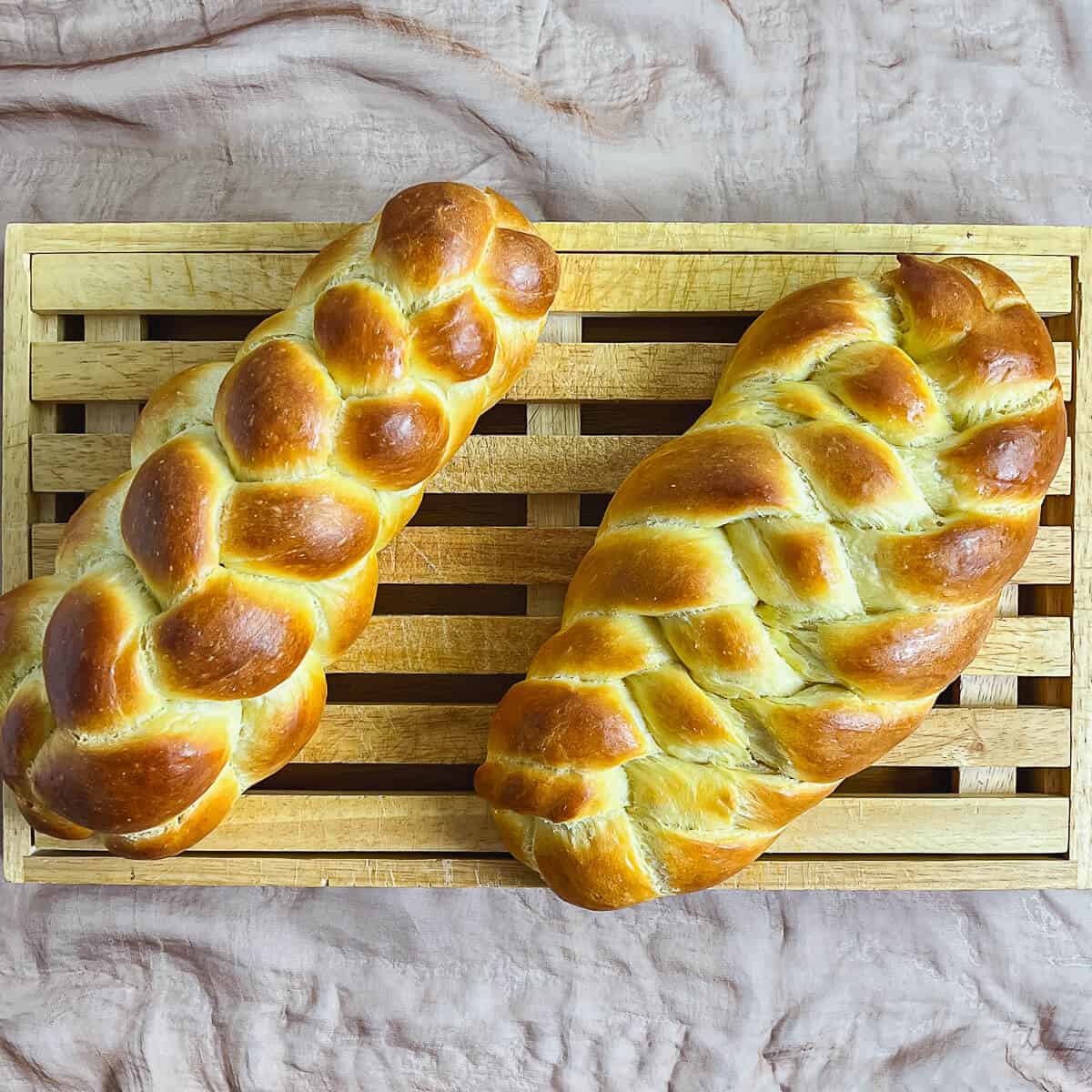
Jump to:
Why these instructions work
- Clear step-by-step instructions and photos for braiding a straight and flat six-strand challah bread
- See the braiding in action on the video
Whether it’s straight, round, squared off, or in a wreath, bread comes in a variety of shapes.
Most types of bread aren’t associated with a specific shape, but challah bread, a Jewish egg-enriched bread, definitely is one of those. Braided, either straight or round, that’s the shape of challah. It’s instantly recognizable.
Straight challahs are served at many Jewish celebrations, from the weekly Shabbat (Sabbath) meal to weddings and Bar/Bat Mitzvahs. And of course, it's great for making french toast!
This egg bread can be braided with three-strands, four-strands, six-strands, or even eight-strands. Braiding challah takes a little practice, but your reward is a beautiful shiny bread suitable for celebrations.
Recipe Ingredients
You'll need the following ingredients to make a challah recipe:

Ingredient Notes
As with most bread recipes, you need the basic bread ingredients: flour, water, yeast, and salt.
Eggs: The main difference between a basic bread dough and challah is that challah dough is enriched with eggs, like with a brioche recipe.
Canola oil: Oil is used instead of softened or melted butter to keep the bread dairy-free. That's especially important if you're keeping Kosher and want to serve the challah with a meal featuring meat. Jewish dietary laws forbid the mixing of milk and meat products at the same time.
Sugar: Challah is usually sweetened with sugar or honey for better flavor.
Mix-ins: These can be a fun way to add another flavor component to your challah. Some common mix-ins are raisins and chocolate chips, but you can experiment with other options like nuts, seeds, or chopped dried fruit.
Toppings: Sesame seeds and poppy seeds are common, and cinnamon sugar (1 teaspoon cinnamon mixed with 1 tablespoon granulated sugar) is a fun alternative. You can also go savory with spice mixes like za'atar. Get creative or leave it plain, your choice.
Here's the best homemade challah recipe, hands down. And as the dough rises, let's discuss how to braid it using a 6-strand braid, both straight and flat.
How to weave a straight six-strand challah
Straight six-strand braids are a little trickier than a basic 3-strand braid, but the technique isn't hard to master. With a little practice, your challah will look like it came straight from the bakery!
Step 1
Portion out 6 equal pieces of dough, cutting it with a bench scraper or knife (for the best accuracy, weigh the dough with a kitchen scale). Shape each piece into a long rope. Lay all the ropes side by side on a lightly floured surface and pinch them together at the top.
Take the topmost right strand and place it on the opposite side. You're only going to do this step once (photo 1).

Step 2
Take the second from the top left strand and place it on the opposite side. Take the topmost left strand and place it in the middle of the four remaining strands (photo 2).

Step 3
Take the second from the top right strand and place it on the opposite side. Take the topmost right strand and place it in the middle of the four remaining strands (photo 3).

Step 4
Repeat steps 2 and 3 until all the dough is braided.
Tuck the ends of the loaf underneath on both ends to give a neat finish. Adjust the braid ends and sides with your hands to make everything even (photo 4).
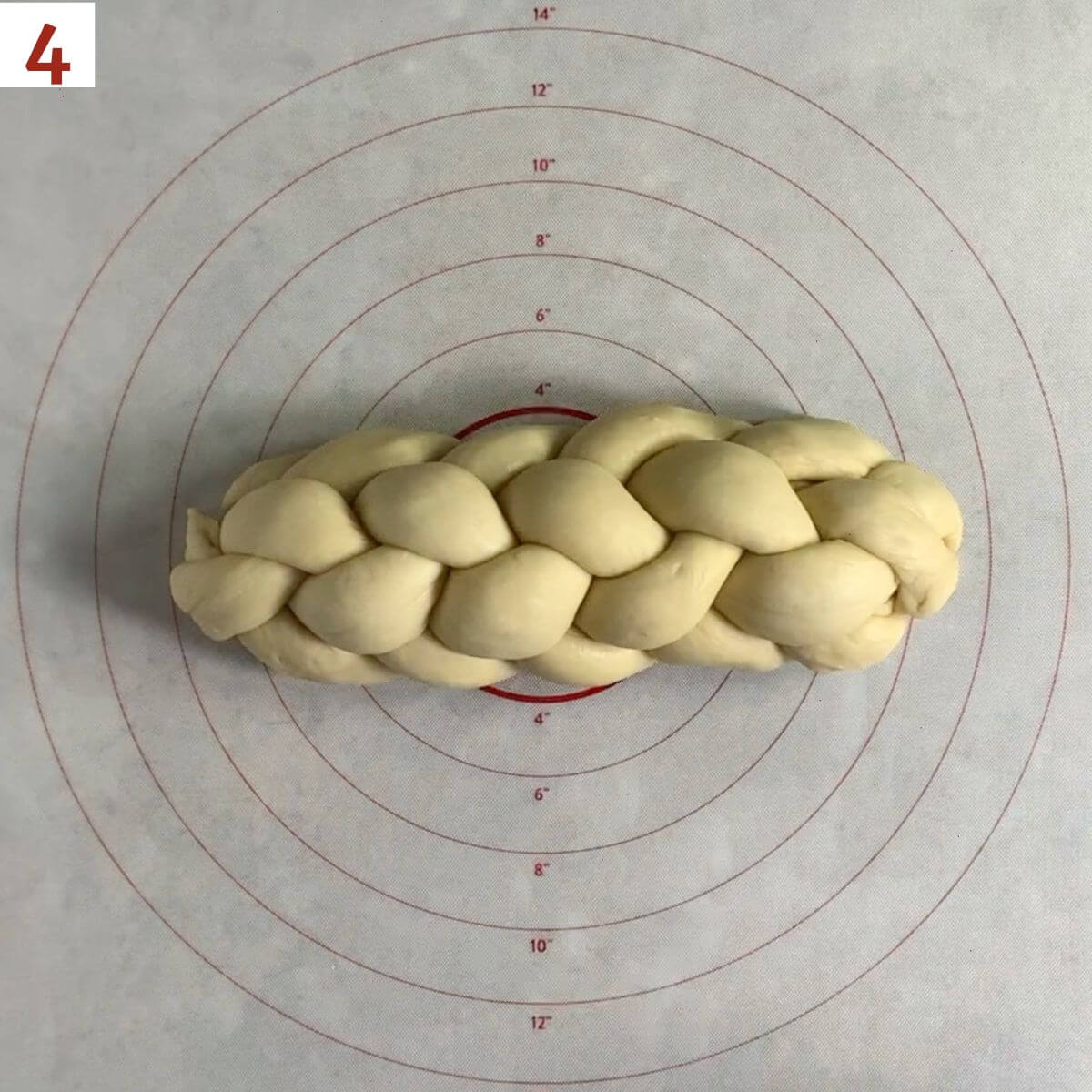
How to weave a flat six-strand challah
On Instagram I discovered @mandyliciouschallah, a self-proclaimed challah guru who puts up videos in the highlights on her profile of incredible looking challahs. She posted an alternative method for shaping a six-strand flat challah.
This method's pattern is considerably easier to remember: take the right strand, and go to the left jumping over the adjacent two strands, under the next one strand, and over the last two strands. So simple!
Step 1
Once again, portion out 6 equal pieces of dough, cutting it with a bench scraper or knife (for the best accuracy, weigh the dough with a kitchen scale). Shape each piece into a long rope.
Take the rightmost strand and jump it over the next 2 strands, under the 3rd strand, and over the next 2 strands (photo 5).

Step 2
Repeat with the new rightmost strand, and continue the pattern until all the dough is braided (photo 6).

Step 3
Tuck the ends of the loaf underneath on both ends to give a neat finish. Adjust the braid ends and sides with your hands to make everything even (photo 7).
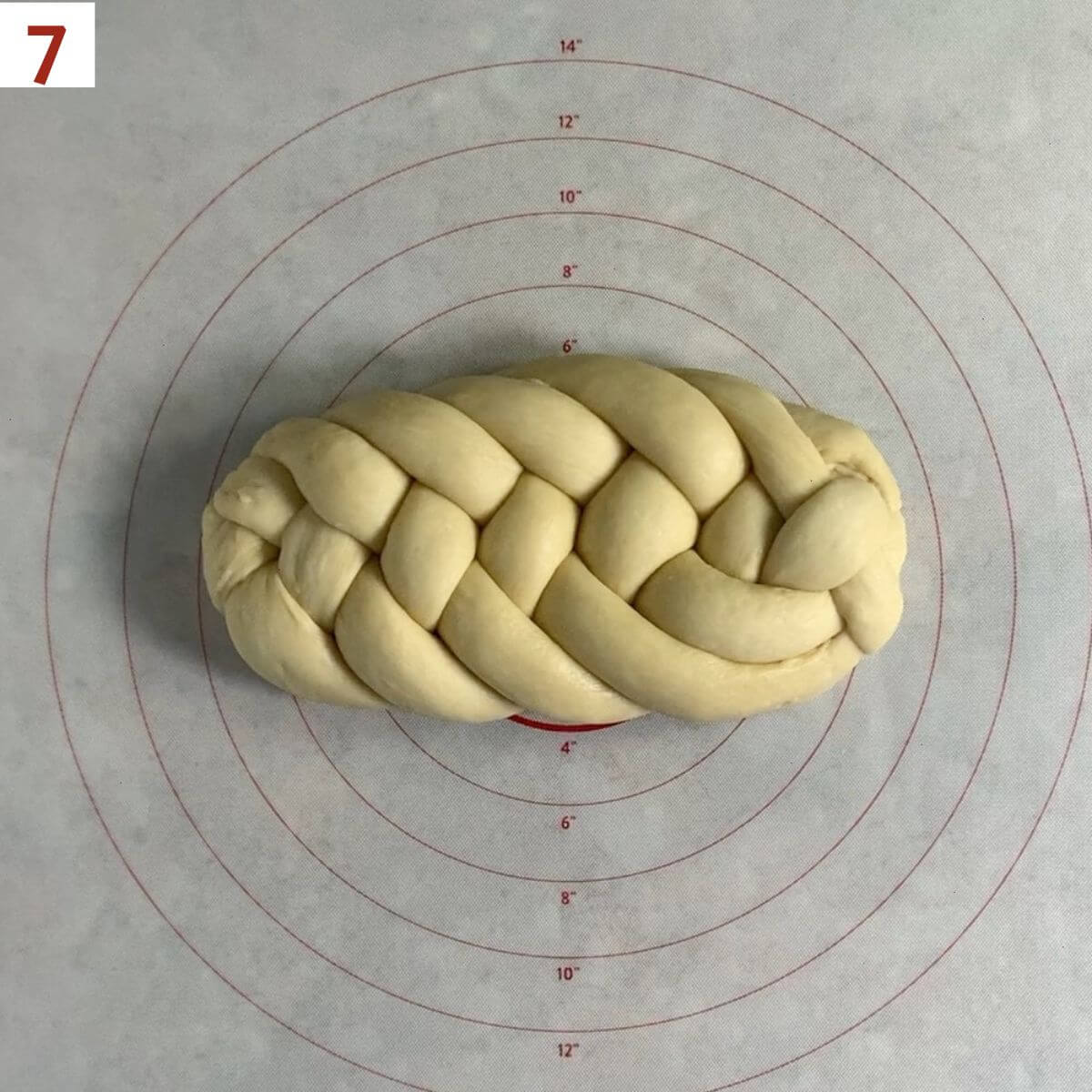
Rest and bake the challah
Continuing with the challah recipe (regardless of the shape), line a half sheet baking pan with a Silpat silicone mat or parchment paper. Transfer the shaped dough to the baking pan, then cover with greased plastic wrap. Let the shaped dough rise for 45 minutes in a warm place.
Brush the dough with an egg beaten with 1 tablespoon of water, then sprinkle on any desired toppings. Bake at 350˚F for 25 to 35 minutes, rotating the pan front to back halfway through the baking time.
When the loaf is golden brown and it sounds hollow when tapped on the bottom (or reads 190°F on a digital thermometer), remove it from the oven and cool on a wire rack (photo 8).

Storage instructions
Challah will last for several days on the counter in an airtight container. For longer term storage, freeze the loaf, well wrapped in plastic wrap and placed in an airtight container, for up to 4 to 6 months.
Questions asked and answered
Here are some questions you might have...
When you start the braid, you tightly pinch the ends of the strands together. After you've come to the end of the strands, you also pinch them together, then tuck both ends under to keep them from coming apart while baking. You'll want to pay special attention to this step.
Sometimes despite your best efforts, the ends will come apart while the challah is baking. I call these lobster claws, and while the challah won't look quite as neat, it will still taste fantastic.
It’s hard to write how to pronounce the word challah. The beginning sound doesn’t exist in English. The “ch” is the anglicized version for the Hebrew letter “chet” which represents the sound you make when you’re trying to clear your throat, not the sound starting “cheese.” That’s why you’ll see the Jewish December holiday of Hanukkah sometimes spelled “Chanukkah.”

There are many ways to shape challah
A braided challah, all shiny and golden brown, is a work of art as well as a delicious bread. Slice it neatly, or use the bumps from the braids to tear off a piece!
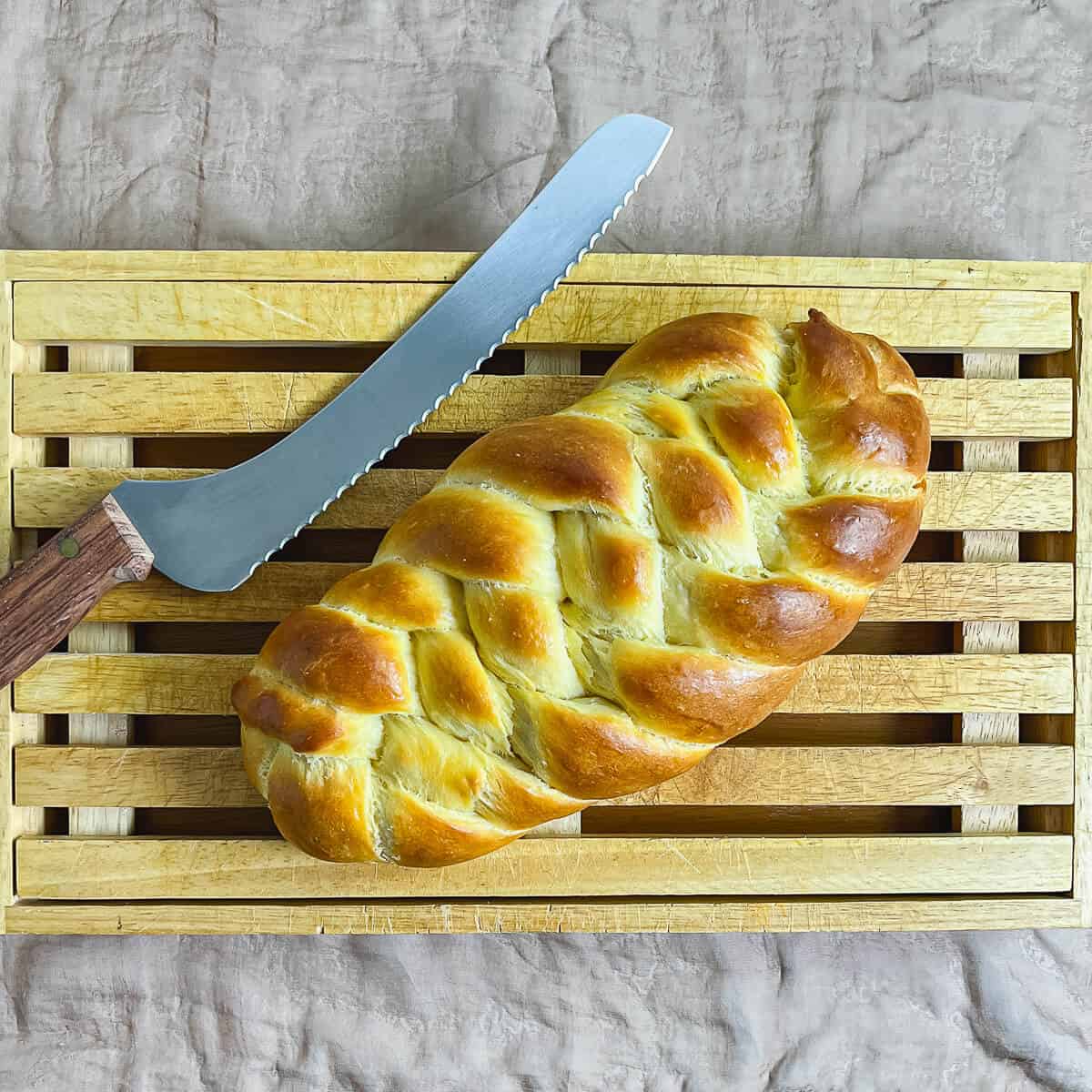
Practice with patience and soon you’ll master the patterns for shaping challah dough. You'll impress your family and friends, and you'll have the satisfaction you plaited like a pro with a challah bread worthy of a bakery, and that’s worth celebrating. Happy braiding!
Slainté! L’chaim! Cheers!
Tammy
Try these recipes next
These recipes are for shaped bread, like challah and babka, and some even use sourdough starter discard. Go ahead and play with your food! Here are some ideas to get you started:

I hope you like this recipe! Do you have any questions I can help with? Let me know! Or, if you made the recipe, I'd love for you to leave a comment and rating. Thanks!

Six Strand Braided Challah Two Ways
Equipment
Ingredients
- 1 recipe homemade challah dough
- 1 large egg, plus 1 tablespoon water, for egg wash
- toppings, optional, see Recipe Notes
Instructions
- Portion out 6 equal pieces of dough, cutting it with a bench scraper or knife (for the best accuracy, weigh the dough with a kitchen scale). Shape each piece into a long rope. Lay all the ropes side by side on a lightly floured surface and pinch them together at the top.
For a straight challah
- Take the topmost right strand and place it on the opposite side. You're only going to do this step once.
- Take the second from the top left strand and place it on the opposite side. Take the topmost left strand and place it in the middle of the four remaining strands. This is the first step of the repeating pattern.
- Take the second from the top right strand and place it on the opposite side. Take the topmost right strand and place it in the middle of the four remaining strands. This is the second step of the repeating pattern.
- Repeat steps 2 and 3 until all the dough is braided.
- Tuck the ends of the loaf underneath on both ends to give a neat finish. Adjust the braid ends and sides with your hands to make everything even.
For a flat challah
- Take the rightmost strand and jump it over the next 2 strands, under the 3rd strand, and over the next 2 strands.
- Repeat with the new rightmost strand, and continue the pattern until all the dough is braided. Pinch the leftover ends together and tuck under the loaf.
Rest and bake the challah
- Line a half sheet baking pan with a Silpat silicone mat or parchment paper. Transfer the shaped dough to the baking pan, then cover with greased plastic wrap.
- Let the shaped dough rise for 45 minutes in a warm place. Preheat the oven to 350 °F.
- For the egg wash, whisk together the beaten egg with the water. Brush the dough with the egg wash, then sprinkle on any desired toppings.
- Bake the dough for 25 to 35 minutes, rotating the pan front to back halfway through the baking time. When the loaf is golden brown and it sounds hollow when tapped on the bottom (or reads 190 °F on a digital thermometer), remove it from the oven and cool on a wire rack.
- Storage instructions: Challah will last for several days on the counter in an airtight container. For longer term storage, freeze the loaf, well wrapped in plastic wrap and placed in an airtight container, for up to 4 to 6 months.

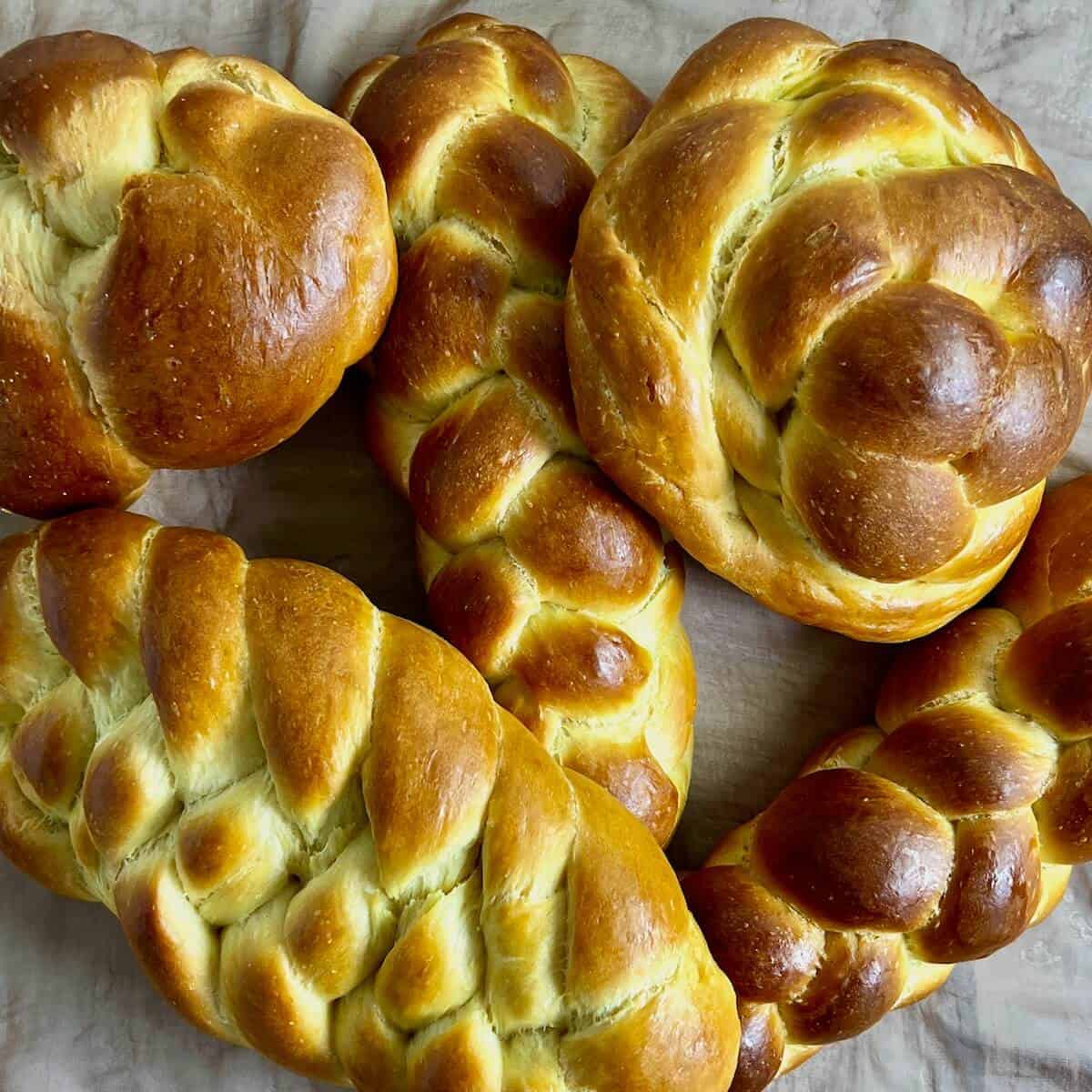

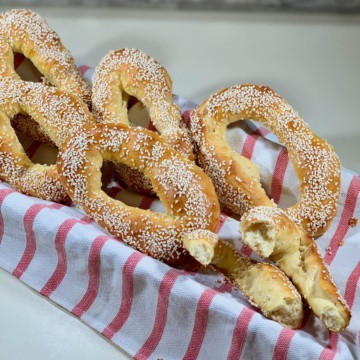




Comments
No Comments